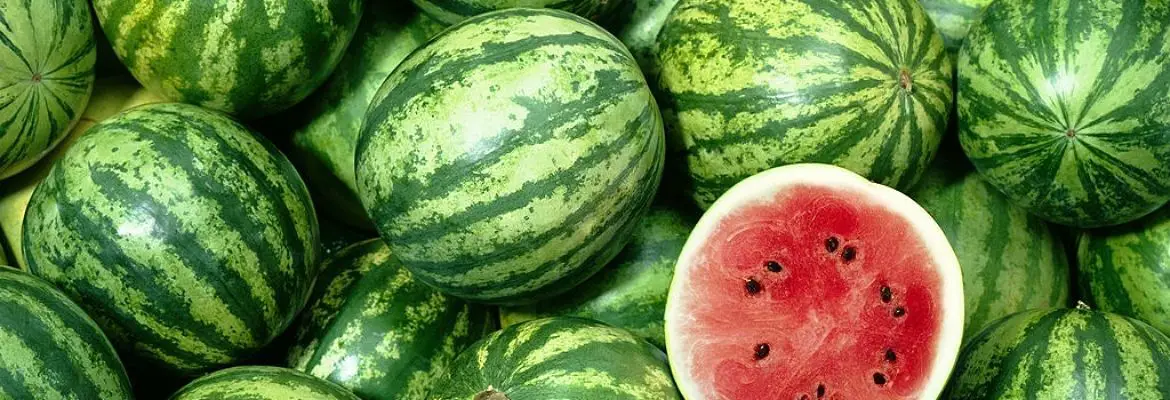The watermelon belongs to the Cucurbitaceae family and is a flowering plant. It has sweet tasting red flesh.
Originally domesticated in Africa, it grows on a vine like plant. Its now grown worldwide in tropical or tepid climate.
Wild watermelon can have a diameter of 8 inches (20 cm) and domestically grown watermelons can be as big as 24 inches (60 cm) or more. The weight of the watermelon has a big range depending on the location and farming practice used to grow it. Watermelon can weigh from 3.3 pounds (1.5 KG) to as large as 25 pounds (11.3 KG).

Scientific name of Watermelon
Citrullus Lanatus
Other names of Watermelon
- Sandía
- Melancia
- Pastèque
Calories by source in Watermelon
- Calories by carbohydrate in Watermelon = 89%
- Calories by fat in Watermelon = 4%
- Calories by protein in Watermelon = 7%
Fats and Fatty Acid profile of Watermelon
- Polyunsaturated fat (PUFA) in Watermelon = 49%
- Saturated fat (SFA) in Watermelon = 16%
- Monounsaturated fat (MUFA) in Watermelon = 35%
Nutrition facts of Watermelon
*Serving size = 100 grams = 3.55 Ounces = 1/2 cup
*DV= % Daily Value (%DV indicates how much nutrients contribute to a person’s daily diet from a serving of a food. DV assists you in determining whether or not a serving of food is high or low in a particular nutrient.)
| Nutrient | Amount | Unit | DV |
|---|---|---|---|
| Calories | 30 | KCAL | |
| Fat | 0.15 | GRAM | 0% |
| Protein | 0.61 | GRAM | 1% |
| Carbohydrate | 7.55 | GRAM | 3% |
Detailed vitamin profile of Watermelon, vitamin A, vitamin B12, vitamin B6, vitamin C, vitamin D, Folate, Niacin, Thiamin, and Riboflavin is shown in the chart.
Detailed mineral profile of Watermelon, Sodium(Na), Calcium(Ca), Copper(Cu), Iron(Fe), Magnesium(Mg), Selenium(Se), Phosphorus(P), Potassium(K) and Zinc(Zn) is shown the chart.
Check freshness in Watermelon
- Undamaged, dark green colored, and dull skin
- Should not be squishy. Should be dense and heavy for its size
- Should have shine and feel slippery to the touch and not sticky
- Mature watermelon will have yellowish brown stem. Immature watermelons typically have green stem
- Ideal size of watermelon depends on its location and general culture followed by the population in that location. For easy handling, 3 pound to 6 pound of water melon is recommended.
- Watermelon will have a yellow spot called “field spot” where it rest on the land while it grows in the vine.
- Try and pick a more rounder watermelon. Rounder melons tend to be more flavorful and less watery when compared to Oval shaped watermelons.
- Taping on the watermelon and listening to the sound will give you an idea of watermelons ripeness. Ripe watermelons may produce a muffled, dull tenor sound. Under-ripe watermelon may produce a denser “metallic” sounding ring.
- When choosing from pre-cut watermelons, choose the one with the bright red color
Availability of Watermelon
- Generally available round the year
- Best season is from May to September
How to store Watermelon
- Uncut watermelon can last up-to 1-2 weeks in room temperature (avoiding extreme temperatures and direct sunlight)
- Watermelon will stop ripening when harvested from the vine
- Refrigerated uncut watermelon can last for 1 week. Preferred temperature should not be less than 50 Fahrenheit (10 degree Celsius) or else it will start decaying after few days
- Cut watermelon should be wrapped in food grade plastic bags or container and can be stored in refrigerator for 4-5 days.
- If cut watermelon is stored in refrigerator without a container then drying of the watermelon pieces will occur
Complete nutrition facts of Watermelon
Click on the link HERE to download high quality, high resolution and print ready PDF version of the Watermelon nutrition chart/infographic.


